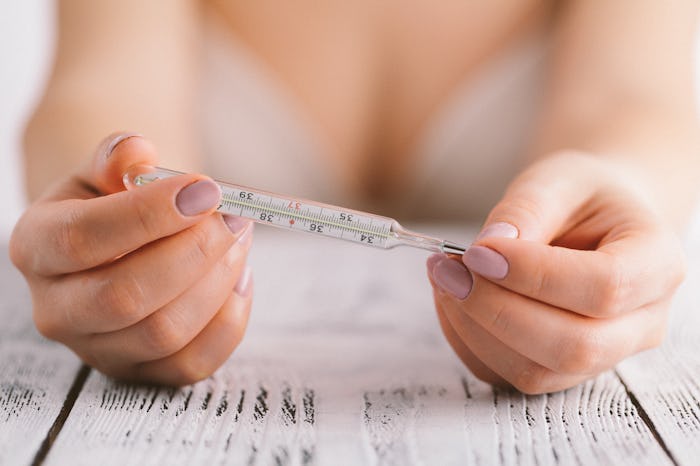Life

Here's How That Temp Rise On Your Fertility Chart Can Help You Time Sex
Ovulation can be a tricky thing to track. While some women experience cramping (or "mittelschmerz"), other women are totally unaware of all this egg-releasin' going on in their bodies. When you're trying to conceive, however, ovulation ignorance is certainly not bliss. One way to keep tabs on your cycle is through charting your basal body temperature, or BBT. So, I want to know: how accurate is this method? And what does it even determine? Does a temperature rise mean ovulation, and can it help you get pregnant?
First, let's look at what exactly basal body temperature is. According to Parents, this is your temperature when your body is at rest. Most women prefer to take their basal body temperature first thing in the morning, before they've done anything. Before they've had coffee, brushed their teeth, had morning sex, made breakfast — you get the point. The goal is to determine your temperature before anything else could possibly affect it, and to take it at approximately the same time each morning.
Once you've figured out how to accurately measure your basal body temperature, the key is to start tracking it. Stash a notepad or a calendar near your bed, and write down your temperature every single morning. Per the instructions from Parents, you'll want to record your BBT within one-tenth of a degree each time. Do this on a daily basis, and you'll start to observe temperature patterns in your monthly cycle.
But back to the main question at hand: does an increase in temperature mean that you've ovulated? According to Dr. Alan Copperman, Medical Director at Progyny, it does indeed. "The body’s temperature rises just after ovulation. It is thought that the progesterone secreted by the ovary following ovulation is largely responsible for the temperature rise," he says in an interview with Romper.
Don't expect your basal body temperature to shoot up dramatically, however. According to the experts at Baby Center, your average BBT before ovulation will typically hover somewhere between 97.2 and 97.7 degrees Fahrenheit. Then, once ovulation occurs, you'll likely see an increase of only about 0.5 to 1.0 degrees. This temperature increase will occur 12 to 24 hours after ovulation, so if you want to get pregnant... get busy as soon as you see that increase. (Because chances are your egg might already be gone by the time you get it done.) Ideally, once you've tracked your BBT for awhile and have recognized certain patterns, you'll know when to expect ovulation. Then, it's beneficial to have sex in the days preceding ovulation as well — that is, if you're hoping to conceive.
Of course, like with any science, certain variables can throw off your data. According to Parents, anything that affects your temperature — fevers, sleeping with heated blankets, drinking alcohol, and so on — can affect your temperature readings. While you can't control all factors, make sure to note these circumstances wherever you're tracking your temperatures. That way you'll remember which readings may be flukes, and which ones actually signify changes in your cycle.
Ready to start charting your own basal body temperature? Don't just reach for the old thermometer in your medicine cabinet. Dr. Joseph Hill, a reproductive endocrinologist and infertility specialist, urged women to use a special basal thermometer when tracking their BBT. "BBT thermometers have a number of advantages: They're speedy, durable, and accurate to a 10th of a degree. Plus, they can store your temperature if you don't want to chart it right away," Hill said in a Q&A for The Bump.
Now that you're "in the know" about basal body temperature in relation to ovulation, you have yet another way to decipher your monthly cycle. By monitoring your daily temperatures and taking note of other small physical changes, you're bound to hear everything your body is telling you — whether it's a scream or a whisper.
This article was originally published on